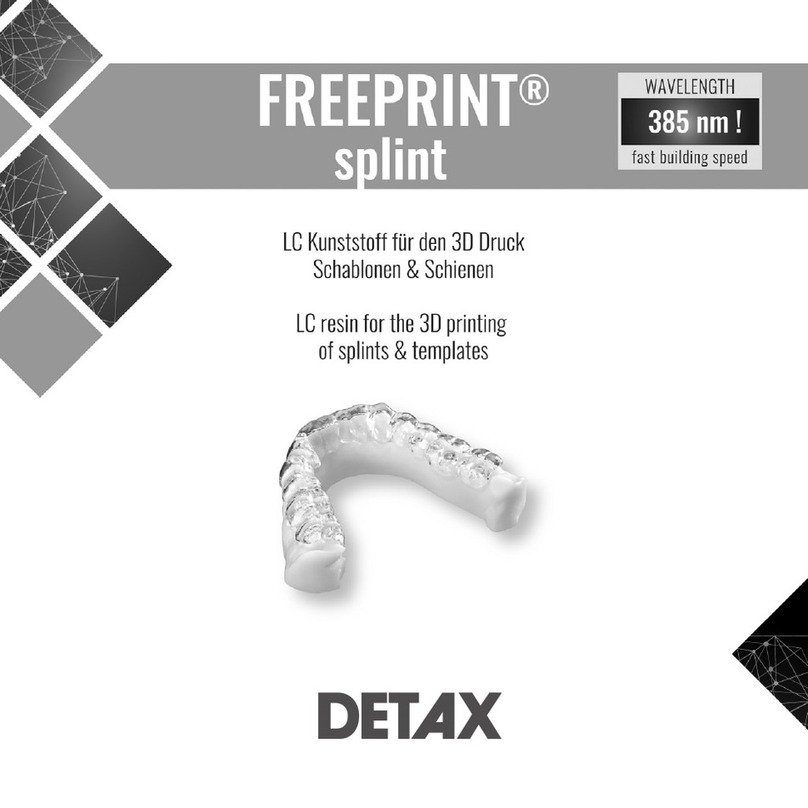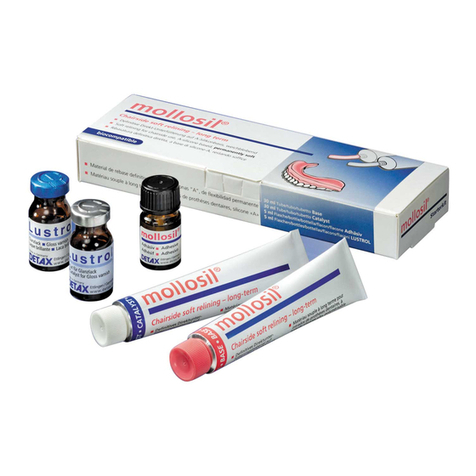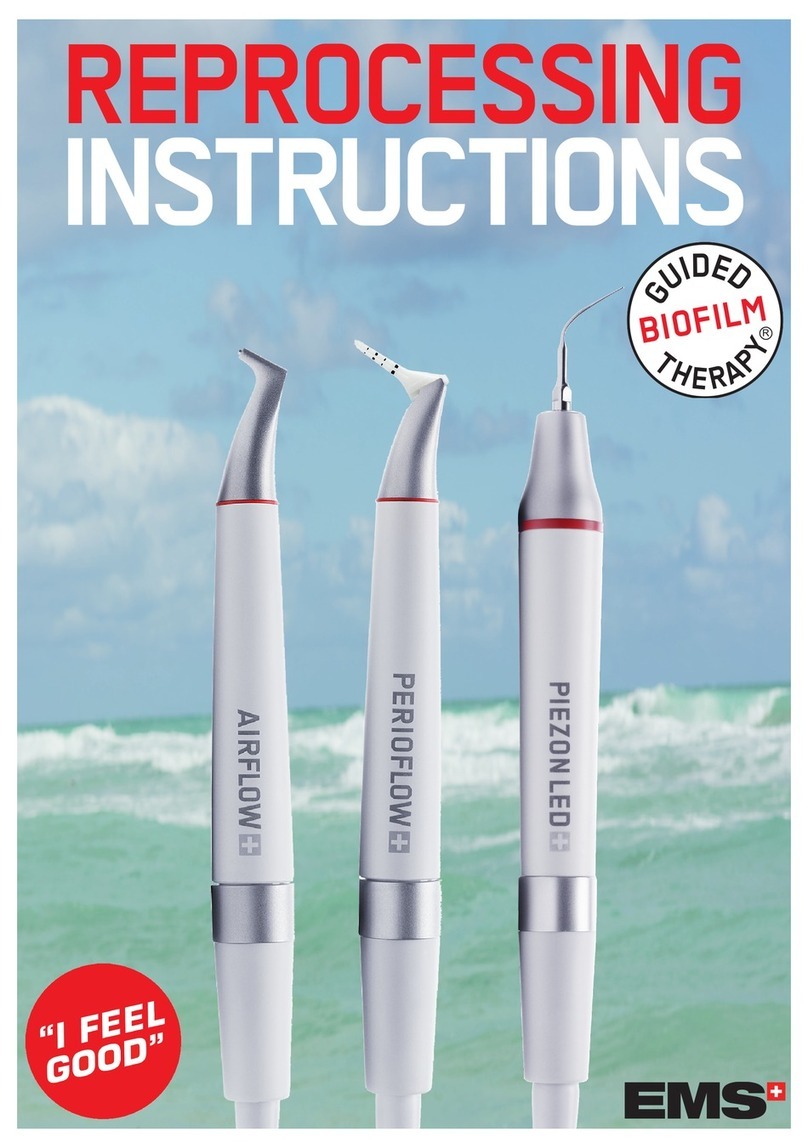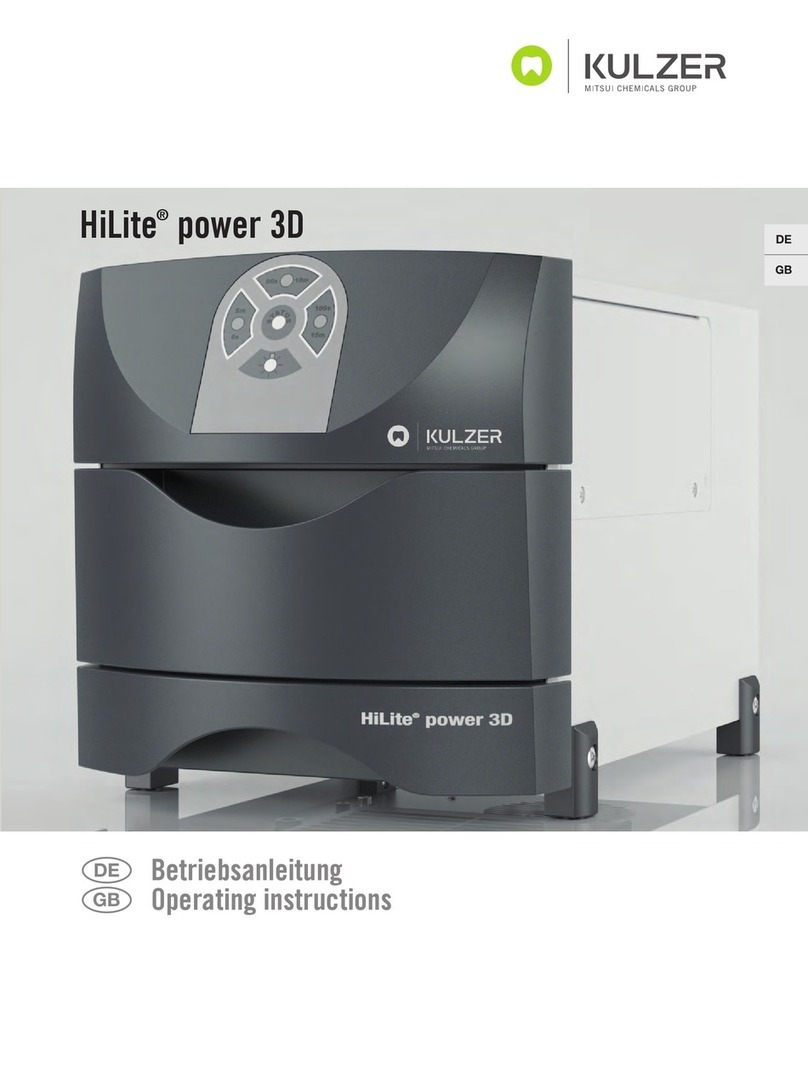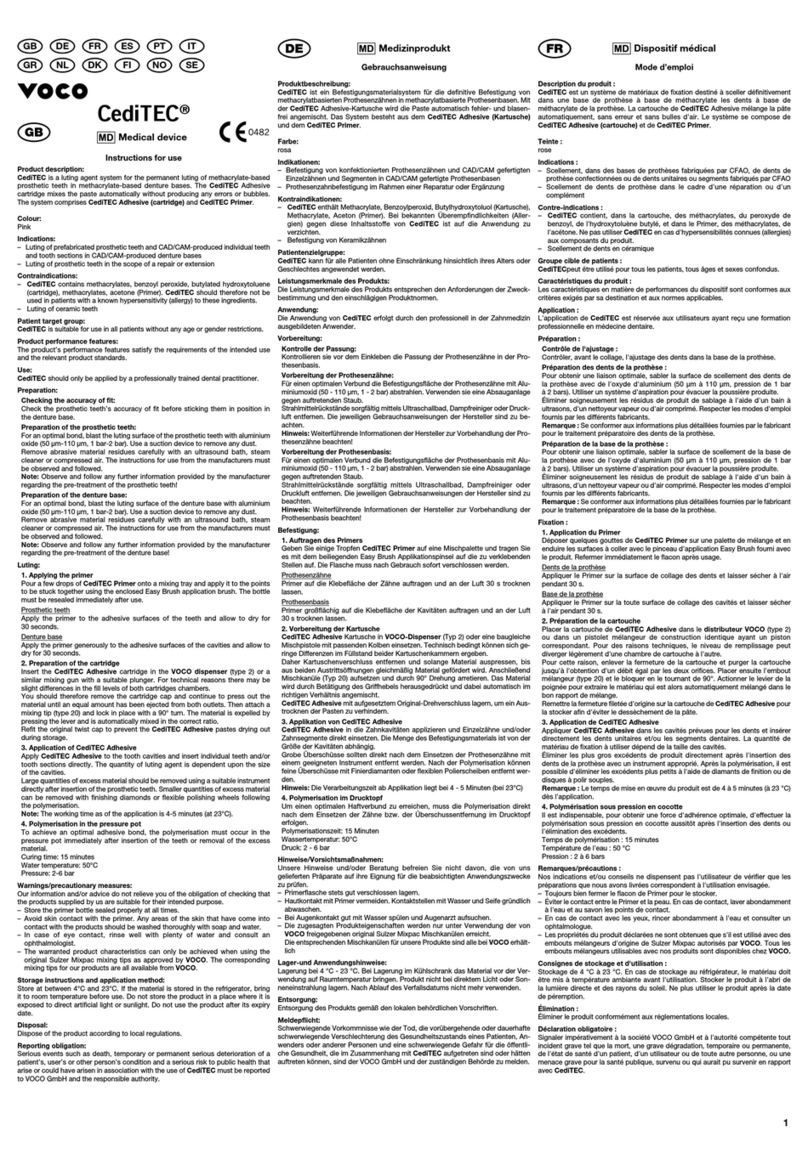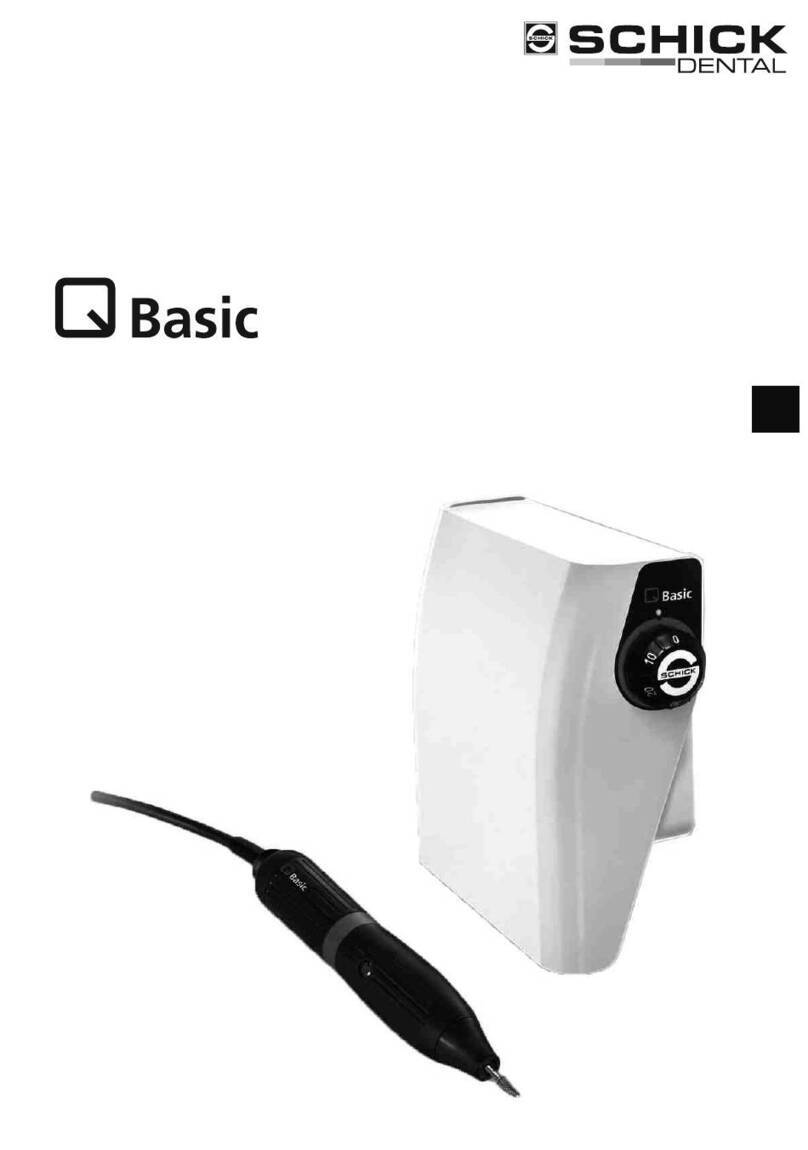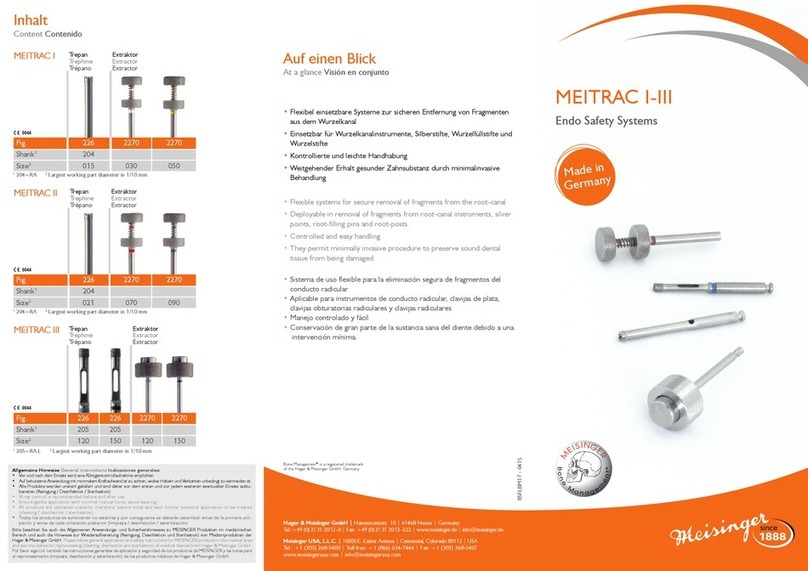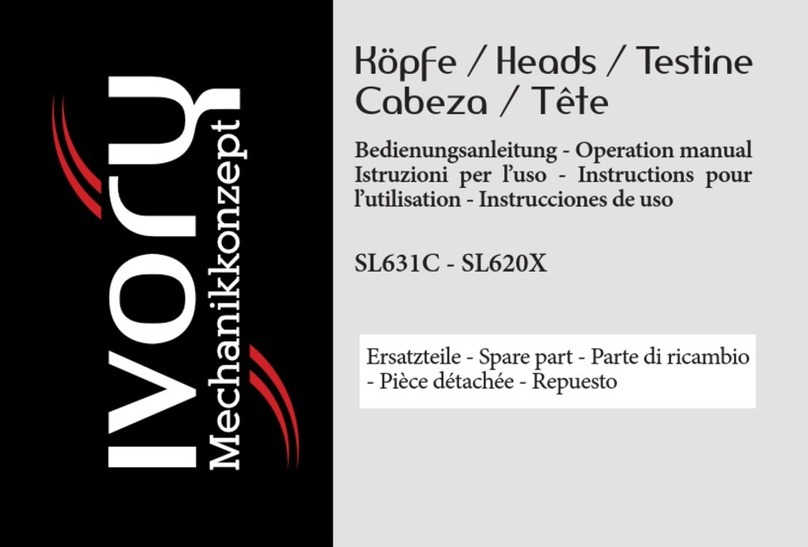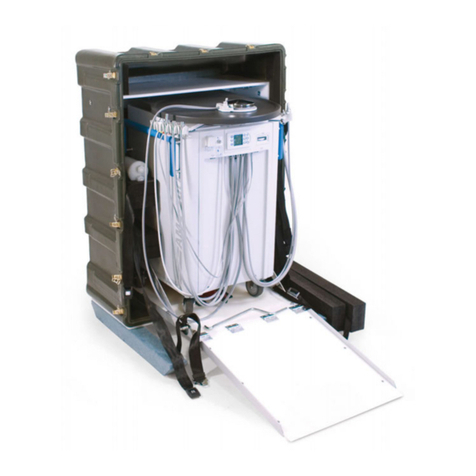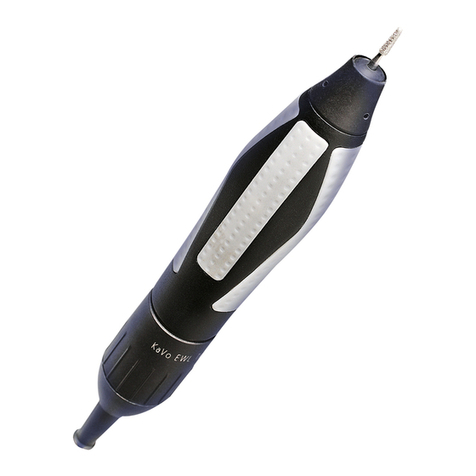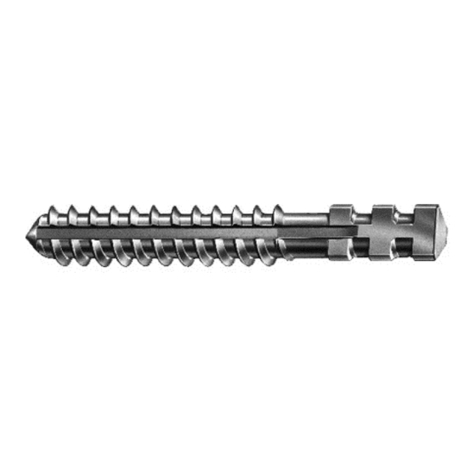Detax PERMALINER 02092 User manual

Denitive Prothesenunterfütterung
PERMA
Denture Reliner
Soft denture relining silicone

2 |
Gebrauchsanweisung............................... 4
Mode d’emploi ..........................................20
FR
Istruzioni per l’uso....................................36
IT
Bruksanvisning..........................................92
NO
Instrukcja stosowania .......................... 100
PL
Manual de instruções........................... 108
PT
DE
Instrucțiuni de utilizare ....................... 116
RO
Bruksanvisning....................................... 124
SV
Instructions for use ..................................12
EN
Modo de empleo......................................28
ES
Brugsanvisning..........................................44
Upute za uporabu ....................................60
HR
Naudojimo instrukcija ............................76
LT
Návod na použitie................................. 132
SK
Navodila za uporabo............................ 140
SL
Návod k použití...................................... 148
CS
DA
Használati útmutató............................. 156
HU
Инструкция по применению ......... 164
RU
Οδηγίες χρήσης.........................................52
EL
Lietošanas instrukcija..............................68
LV
Gebruiksaanwijzing.................................84
NL Kullanım Talimatları .............................. 172
TR

Ordering information
PERMALINER
jar of 30 g......................................................02092
jar of 70 g......................................................02146
Milling cutters
Set of 3 pcs. .................................................03101
Polishing discs
10 pcs. + 1 mandrel...................................03153
Grinding caps
1 pc. grinding cap holder, pointed ........02616
10 pcs. grinding caps, pointed ...............02615

4 |
Zweckbestimmung:
Denitive Unterfütterung von Zahnprothesen
Patientenzielgruppe:
Personen, die im Rahmen einer zahnärztlichen Maßnahme behandelt werden.
Vorgesehene Anwender:
Zahntechniker/-in
Indikation:
Geeignet für alle PMMA-Kunststoe.
►Zur Anfertigung dauerhaft weichbleibender Unterfütterungen im zahntechnischen Labor.
►Beseitigung von Druckstellen in OK- und UK- Bereichen, bei Haftschwierigkeiten und Schlotterkamm.
►Zur Abdämmung der A-Linie, als elastischer Abschlussrand an OK-Prothesen und zur Lagesicherung der
Prothesen durch erhöhte Adhäsion.
►Zur elastischen Abdeckung scharfkantiger Alveolarfortsätze.
►Zur Abdeckung von Implantatbereichen und als Overdentures.

| 5
DE
►Zur Abdeckung größerer, durch Missbildungen oder Operationen entstandener Defekte.
Unterfütterung mit PERMALINER bei Neuanfertigung einer Prothese
Gipsmodell
►Zu Beginn wird ein Gipsmodell der Klasse 3 hergestellt.
Platzhalter
►Der Platzhalter wird am besten im Tiefziehverfahren angefertigt. Dessen Stärke sollte zwischen 1 mm
und 3 mm betragen, sie wird vom Zahnarzt festgelegt. Der Platzhalter kann auch mit Kaltpolymerisat
z.B. aus Löffelmaterial angefertigt und zur gewünschten Stärke getrimmt werden.
Einbetten
►Die Wachsaufstellung mit Platzhalter in einer Küvette für Presstechnik einbetten. Eine Isolierung der
Zahnreihen im Konter mit FLEXISTONE® oder FLEXISTONE® Plus wird empfohlen. Küvette ca. 4 Min. in
kochendes Wasser legen, önen und sorgfältig ausbrühen. Platzhalter vorher entfernen.
Isolierung
►Gebräuchliche Alginatisolierung verwenden. Danach Platzhalter wieder in seine Position bringen.

6 |
Pressen und Anpolymerisieren des Acrylats
►Das Acrylat wird nach Gebrauchsanweisung angeteigt und gestopft. Zwischen Acrylat und Platzhalter wird
für den Pressvorgang eine Polyethylenfolie gelegt. Die Küvette in Intervallen für ca. 10-15 Min. mit 1,5 to.
vorpressen. Nach Önung der Küvette Polyethylenfolie entnehmen und Acrylatüberschuss entfernen.
Küvette mit Platzhalter und Polyethylenfolie wieder schließen und mit Spannbügel nochmals pressen.
Spannbügel schließen, in kaltem Wasser aufsetzen und zum Kochen bringen. Für ca. 30 Min. kochen,
dann abkühlen lassen. Durch diese Vorpolymerisation werden evtl. Reaktionen mit dem Acrylat-Monomer
vermieden. Küvette aus dem Spannbügel nehmen und önen. Platzhalter und Polyethylenfolie entfernen.
Vor dem Stopfen von PERMALINER muss das Acrylat einen hohen Steifheitsgrad erreicht haben, um
Verformungen zu vermeiden.
Stopfen von PERMALINER
►Das gebrauchsfertige PERMALINER mit einem sauberen Spatel aus der Dose entnehmen und auf
das Acrylat vorlegen und leicht andrücken. Eine neue Polyethylenfolie zwischen PERMALINER und
Küvettenkonter legen. Die Küvette schließen und in Intervallen mit ca. 1,5 to. vorpressen. Nach Önung
der Küvette Polyethylenfolie und PERMALINER-Überschuss entfernen. Küvette wieder schließen und die
endgültige Pressung mit ca. 3 to. durchführen. Zum Polymerisieren die Küvette unter Pressdruck in den Bügel
einspannen.

| 7
DE
Polymerisation
►Die eingespannte Küvette in kaltesWasserbad legen und langsam auf 100 °C erhitzen.
Polymerisationszeit: 1 Std. bei 100 °C kochen.
Danach Küvette langsam abkühlen lassen. Nicht mit kaltem Wasser abschrecken.
Polymerisation im Mikrowellengerät
►Die Polymerisation erfolgt in geeigneten, handelsüblichen Mikrowellen-Küvetten (Kunststo, zum Pressen
geeignet) bei 850 Watt innerhalb von 10 Min. Zur Einbettung sind mikrowellentaugliche Dentalgipse zu
verwenden. Das Einbetten und die Polymerisation müssen innerhalb von 8 Stunden erfolgen. Geräte ohne
Drehteller können eine stufenweise, allseitige Polymerisation durch Drehen der Küvette erforderlich machen.
Das Ausbetten erfolgt nach selbstständiger Abkühlung auf Raumtemperatur.
Ausarbeiten der Prothese
►Das Acrylat wie üblich ausarbeiten. PERMALINER läßt sich ohne Hitzeentwicklung mit Fräsen oder
Schleifkappen (15 -20 tsd. U/Min.) bearbeiten. Mit Polierscheiben können Unebenheiten beseitigt werden.
Polieren des Acrylats
►Acrylat in herkömmlicher Weise vor- und hochglanzpolieren. PERMALINER kann nicht hochglanzpoliert
werden. Alternativ wird Lustrol Glanzlack empfohlen. Die Dosierung beträgt 1:1. Vor dem Auftragen müssen

8 |
Basis und Funktionsränder sauber und trocken sein. Lustrol mit einem Pinsel auftragen und ca. 10-15 Min.
trocknen lassen. Lustrol ist für Anwendung in Verbindung mit Molloplast® B, Permaliner, mollosil®,
mollosil® plus geeignet.
Unterfütterung einer bereits vorhandenen Acrylat-Prothese mit PERMALINER
►Bei einer getragenen Prothese, die mit PERMALINER unterfüttert werden soll, formt der Zahnarzt
mit der vorhandenen Prothese die Basis neu ab. Zur Abformung werden mittel- oder niedrigviskose
Abformmaterialien verwendet. Die Modellherstellung, das Einbetten und die Isolierung erfolgen wie bereits
beschrieben.
Die Acrylatbasis
►Prothese aus dem Konter entnehmen und das Abdruckmaterial von der Prothese entfernen. Die Basis mit
Fräsen um die gewünschte Permaplast-Stärke (1,0-3,0 mm) reduzieren. Für einen nahtlosen Übergang vom
Acrylat zu PERMALINER ist es empfehlenswert, im Übergangsbereich eine gleichmäßige zirkuläre Stufe
in der gewünschten Permaplaststärke in das Acrylat einzuarbeiten. Altes, bereits vorhandenes weiches
Unterfütterungsmaterial vollständig entfernen.
►Das Stopfen, Pressen, Polymerisieren und die Ausarbeitung von PERMALINER erfolgen wie bereits
beschrieben.

| 9
DE
Hinweise zur Vermeidung von Verarbeitungsfehlern
1. Blasenbildung:
►Zu wenig Druck beim Pressen.
►Küvette in das heiße – statt kalte –Wasserbad gelegt.
►Stopfen von PERMALINER bevor Acrylat fest genug ist.
►Benetzen des Acrylats mit Monomerüssigkeit vor dem Auftragen von PERMALINER.
2. Ungenügende oder keine Verbindung:
►Prothesenbasis nicht ausreichend tief angeraut.
►Die Prothese wurde mit Alginatisolierung benetzt.
►Hände und Prothese waren nicht fettfrei.
►Zu große Hitzeentwicklung bei der Ausarbeitung kann zum Ablösen von PERMALINER an den Rändern
führen.
Hinweise zur Reparatur von PERMALINER
►PERMALINER kann mit sich selbst repariert und ergänzt werden. Dazu die Prothese einbetten. Vorhandenes
PERMALINER und Kunststo gut aufrauen. Neues PERMALINER zur Ergänzung im Reparaturbereich in die
Küvette legen und pressen (Probepressung mit Folie möglich). Anschließend nach Anleitung polymerisieren.

10 |
Sicherheitshinweise
►Nur für die angegebene Zweckbestimmung durch geschultes Fachpersonal.
►Gefahren- und Sicherheitshinweise aus dem entsprechendem Sicherheitsdatenblatt entnehmen.
Hinweise
►DETAX haftet nicht für Schäden, die durch fehlerhafte Anwendung hervorgerufen werden.
►Sicherheitsdatenblatt beachten!
Für Anwender und / oder Patienten
Alle im Zusammenhang mit diesem Produkt aufgetretenen schwerwiegenden Vorfälle sind unverzüglich unter
[email protected] sowie an die zuständige Behörde des Mitgliedstaats, in dem Anwender und/oder Patient
niedergelassen ist, zu melden.
Kontraindikation
Enthält organische Peroxide.
Inhaltsstoe von Permaliner können bei entsprechend disponierten Personen allergische Reaktionen hervorrufen.

| 11
DE
In einem derartigen Fall ist von einer weiteren Anwendung des Produktes abzusehen. Permaliner nur in vollständig
polymerisiertem Zustand intraoral einbringen.
Nebenwirkungen
Produkt kann allergische Reaktionen hervorrufen.
Entsorgung
Die Entsorgung des Inhalts/des Behälters gemäß den örtlichen/regionalen/nationalen und internationalen
Vorschriften durchführen.
Symbolerläuterung
Medizinprodukt
siehe Boden

12 |
Intended Use:
Denitive relining of dental prostheses
Patient Target Group:
Persons being treated in the context of a dental procedure.
Intended Users:
Dental technician
Indication:
Suitable for all PMMA-based plastic materials.
►For fabrication of permanently soft relinings in the dental laboratory.
►Elimination of pressure points in mandibular and maxillary areas, adhesion problems and abby ridges.
►For post-damming the Aline, as an elastic margin on maxillary dentures and for securing the position of the
dentures by increased adhesion.
►For elastic covering of sharp-ridged alveolar processes.
►For covering implant areas and as overdentures.
►To cover larger defects caused by malformations or operations.

| 13
EN
Relining of new dentures with PERMALINER
Plaster cast
►First, a class 3 plaster model is manufactured.
Spacer
►The spacer is ideally produced by deep drawing. Its thickness should be between 1 mm and 3 mm;
it is determined by the dentist. The spacer can also be made with cold-curing polymer, e.g. from tray
material, and trimmed to the desired thickness.
Investing
►Invest the wax pattern with spacer in a ask for the press technique. Insulation of the teeth in the counter
with FLEXISTONE® or FLEXISTONE® Plus is recommended. Place the ask in boiling water for approx. 4
minutes, then open and remove all traces of wax carefully. Remove spacer rst.
Insulation
►Apply conventional alginate insulation.The return the spacer to its position.

14 |
Pressing and pre-polymerization of the acrylic
►The acrylic is mixed and packed according to the instructions for use. A polyethylene foil is placed between
the acrylic and the spacer for the pressing process. Pre-press the ask at 1.5 tons at intervals of approx.10–15
minutes. After opening the ask, remove the polyethylene foil and the excess acrylic. Close the ask again
with the spacer and the polyethylene foil and press it once more with the clamp. Close the clamp, place
the ask in cold water and bring to the boil. Boil for about 30 minutes, then let it cool down. This pre-
polymerization avoids possible reactions with the acrylic monomer. Remove the ask from the clamp and
open it. Remove spacer and polyethylene foil. Before the packing of PERMALINER, the acrylic must have
reached a high degree of stiness to avoid deformation.
Packing of PERMALINER
►Withdraw the ready-to-use PERMALINER from the jar with a clean spatula, place it on the acrylic and
press it on slightly. Place a new polyethylene foil between PERMALINER and the ask counter. Close the
ask and pre-press at intervals with approx. 1.5 tons. After opening the ask, remove polyethylene foil
and PERMALINER excess. Close the ask again and perform the nal pressing with approx. 3 tons. For
polymerization, place the ask in the clamp under pressure.

| 15
EN
Polymerization
►Place the clamped ask in a cold water bath and heat slowly up to 100 °C / 212°F.
Polymerization time: Boil for 1 h @ 100 °C / 212°F.
Then allow the ask to cool down slowly. Do not quench with cold water.
Polymerization in microwave device
►Polymerization takes place in suitable commercially available microwave asks (plastic, suitable for pressing)
at 850 watts within 10 minutes. Microwave-compatible dental plasters must be used for investing. Investing
and polymerization must be carried out within 8 hours. Units without a rotary plate may necessitate gradual
polymerization on all sides by turning of the ask. De-ask after self-cooling down to room temperature.
Trimming of the denture
►Trim the acrylic as usual. PERMALINER can be machined with milling cutters or grinding sleeves (15,000 –
20,000 RPM) without heat build-up. Rough spots can be removed with polishing discs.
Polishing of the acrylic
►Pre-polish and mirror-polish acrylic in the conventional way. PERMALINER cannot be mirror-polished.
Lustrol gloss varnish is recommended as an alternative. The dosage is 1:1. Before application, the base and
functional borders must be clean and dry. Apply Lustrol using a brush and let it dry for about 10–15 minutes.

16 |
Lustrol is suitable for use in combination with Molloplast® B, Permaliner, mollosil®, and mollosil® plus.
Relining of an existing acrylic denture with PERMALINER
►In the case of an existing denture that is to be constantly softly relined with PERMALINER the dentist makes
a new impression of the base with the existing denture. Medium- or light-bodied impression materials are
used for producing the impression. Model fabrication, investing and insulation are carried out as described
above.
The acrylic base
►Take the denture from the counter and remove the impression material from the denture. Reduce the base
with milling by the desired Permaplast thickness (1.0–3.0 mm). For a seamless transition from acrylic to
PERMALINER it is recommendable to cut an even circular shoulder in the transition area into the acrylic in
the desired Permaplast thickness. Completely remove any existing soft relining material.
►Packing, pressing, polymerizing and trimming of PERMALINER are carried out as described above.
Recommendations to avoid incorrect processing
1. Blistering:
►Insucient pressure during pressing.

| 17
EN
►Flask placed in hot – rather than cold – water bath.
►Packing of PERMALINER before the acrylic is sti enough.
►Wetting of the acrylic with monomer liquid before application of PERMALINER.
2. Insucient or no bonding:
►Prosthetic base plate not roughened deeply enough.
►The denture was wetted with alginate insulation.
►Hands and denture were not grease-free.
►Excessive heat build-up during trimming can cause PERMALINER to peel o at the borders.
Recommendations for repairing PERMALINER
►PERMALINER can be repaired and supplemented with itself. Invest the denture for this purpose.
Roughen existing PERMALINER and plastic material well. For supplementation in the repair area, place
new PERMALINER in the ask and press (trial pressing with foil possible). Then polymerize according to
instructions.
Safety Information
►Only for the specied intended use by trained specialists.

18 |
►Refer to the relevant safety data sheet for hazard and safety information.
Notes
►DETAX shall not be held liable for any damage caused by misuse.
►Read and understand the safety data sheet!
For users and / or patients
Any serious incident that has occurred in connection with this product must be reported immediately to
[email protected] and to the competent public authority of the country in which the user and/or patient resides.
Contraindication
Contains organic peroxides.
Ingredients of Permaliner may cause allergic reactions in accordingly disposed persons. In such a case, do not use
the product any further. Apply Permaliner intraorally only when fully polymerized.
Side Eects
Product may cause allergic reactions.

| 19
EN
Disposal
Disposal of the contents/container must be carried out in accordance with the local/regional/national and
international regulations.
Symbols
Medical device
see base

20 |
Destination:
Rebasage dénitif de prothèses dentaires
Groupe de patients ciblés:
Personnes qui doivent faire l’objet de mesures dentaires.
Utilisateurs visés:
Prothésistes dentaires
Indication:
Adapté à tous les plastiques PMMA.
►Pour la fabrication de rebasages souples à long terme dans le laboratoire dentaire.
►Élimination des points de pression dans la MS/MI, en cas de problèmes de tenue et de crête ottante.
►Pour l’amortissement de la ligne A, comme bord élastique pour les prothèses de mâchoire supérieure et
pour assurer la position des prothèses en renforçant l’adhérence.
►Pour le revêtement élastique des os alvéolaires acérés.
►Pour le revêtement des zones implantaires et comme overdenture.
►Pour la couverture de défauts plus importants dus à des malformations ou des opérations.
This manual suits for next models
5
Table of contents
Languages:
Other Detax Dental Equipment manuals
Popular Dental Equipment manuals by other brands
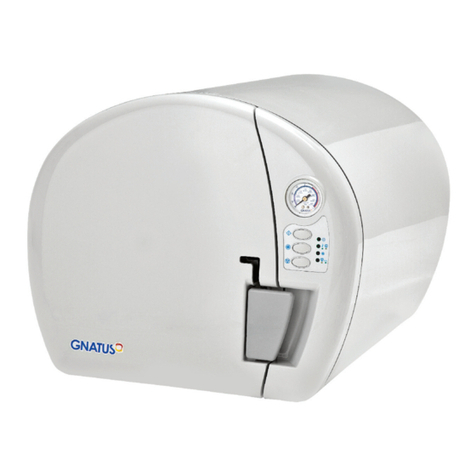
GNATUS
GNATUS Autoclave Bioclave 21L owner's manual
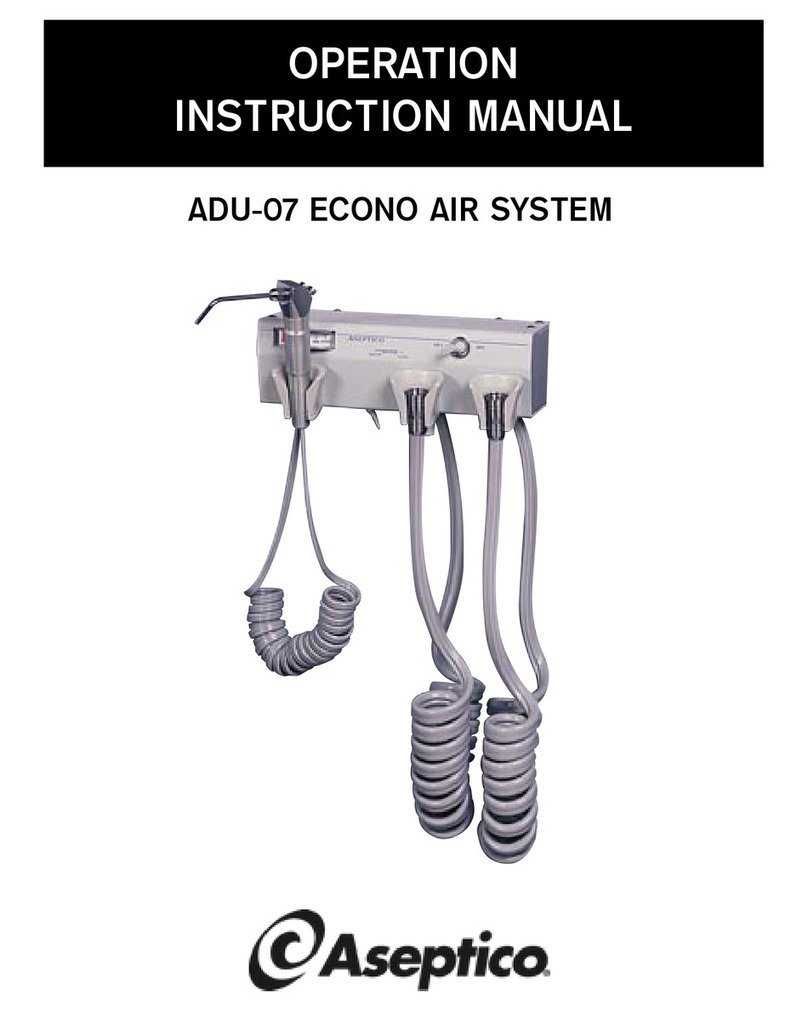
Aseptico
Aseptico ECONO AIR SYSTEM ADU-07 Operation & instruction manual

Castellini
Castellini Puma Eli Instructions use and maintenance handbook
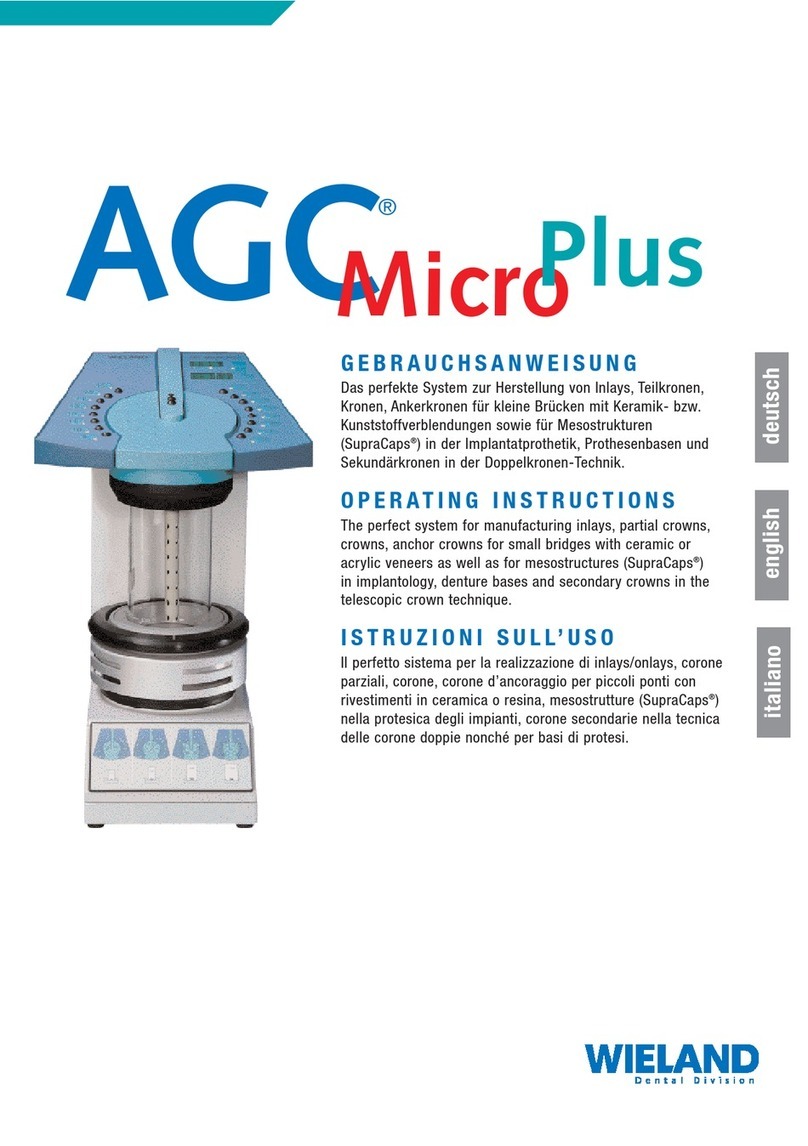
Wieland
Wieland AGC Micro Plus operating instructions

Tecno-gaz
Tecno-gaz Kyri Instructions for use
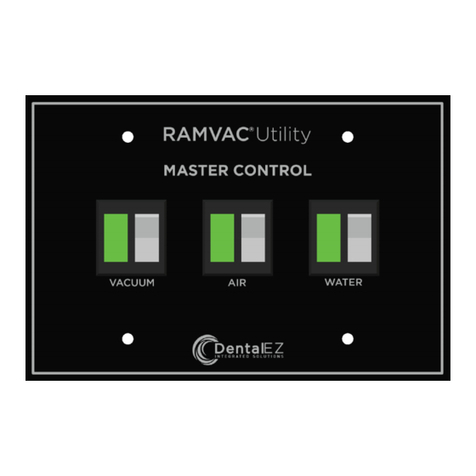
DentalEZ
DentalEZ RAMVAC Utility user manual
